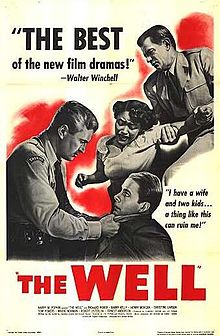
THE WELL
US, 1951, 86 minutes, Black and white.
Richard Rober, Gwendolyn Laster, Maidie Norman, Ernest Anderson, Harry Morgan, Christine Larsen, Tom Powers.
Directed by Leo C. Popkin and Russell Rouse.
The Well is a very interesting film illustrating B-budget film-making of the early 1950s. It is rather melodramatic in its style, at least by contemporary standards. While Dmitri Tiomkin’s score was nominated for awards, it seems highly melodramatic these days.
However, the film reflects the racism of the period. To that extent, it must have been a courageous film to make in the early 1950s. This was the period of Home of the Brave, Pinky, and Sidney Poitier’s early appearance in No Way Out. The film also echoes Billy Wilder’s Ace in the Hole, released the same year – although the attention there was on the media rather than on race issues.
The story takes place over one day. A five-year-old on her way to school stops to pick some flowers and falls down an abandoned well. Rumours start circulating in the town, the little girl was seen with a stranger. He is eventually tracked down, arrested, interrogated, found guilty before being tried – until it emerges that he is the nephew of one of the big wheels of the town. When the black population gather outside the police station, the industrialist is knocked down and goes to hospital. Rumours continue to spread and this is shown quite vividly. They become highly exaggerated. Young people, both black and white, take to the streets, riot, attack each other, break windows, attack shops and loot.
The genial sheriff tries to do his best for the young man, for the family, for justice. He has long discussions with the mayor – especially about calling in the National Guard and the consequences of this.
Eventually, a little boy finds the girls things near the well and the rest of the film shows the town joining together, the industrialist supplying heavy equipment, the young man accused, after some reluctance, bringing his mining skills to the digging of a hole to get the girl out of the well. He offers some heroism at the end by going down to rescue the little girl.
While the film is very much of its time, it is very interesting to look at in order to understand something of American attitudes at the time. The film was nominated for Oscars for editing and for the screenplay and was nominated by the Writers’ Guild as contributing to the exploration of social problems of the period.
1.The impact of the film? Decades later? Estimating the importance and impact of the film in its time?
2.American attitudes of the period, African Americans, whites, antagonisms, prejudice? Living side by side – but provocations able to induce riots and bigotry?
3.The black and white photography, the average American town? The streets and shops, police precinct, the homes? The outskirts? The field with the well? The musical score and its high melodramatic tones?
4.The introduction of the theme: the little girl, African American, going to school, picking flowers, falling down the well? Her spending all day in the well? Her parents eventually coming, calling out to her, her being rescued?
5.The panic in the town, the rumours about the young man seen talking to the girl? His being apprehended, his innocent explanations, people contradicting him? His being taken in by the sheriff, the interrogations? The presumption of his guilt? People gathering, wanting justice? The African Americans and their attack on him? The police, their personalities, the sheriff as fair minded, the bigotry in some of the other police? The mayor, his concern, wanting to do the right thing? As rioting progressed, the decision to call in the National Guard, the pros and cons, creating a panic situation? The time element?
6.The sheriff, his personality, handling the situation, his fiancée, the personal aspects of his life?
7.The girl’s parents, their concern, the attack on the industrialist? His going to hospital? The bitterness on all sides?
8.The young people, coming out in the streets, the white teenagers and their bigotry, brutality, bashing the African Americans? The young blacks, coming out on the street, rioting and looting? The growing battles on the streets?
9.The ordinary people in suburbia, passing on the information, exaggerating it, exacerbating the rumours?
10.The potential for an all-out riot? The manifestation of deep prejudices and hatreds?
11.The voices of common sense, of peace, reconciliation? The grandfather? The role of the various people in the town, the schoolteacher, the florist, the deputies?
12.The young boy, finding the little girl’s things? Information to the police?
13.The change of tone, the need to rescue the girl, everybody joining in? The industrialist and his anger at the factory, wanting lynch law and vigilante behaviour? His being shamed? His concern about his nephew and his talking with him?
14.The nephew, his wanting to leave town, the injustice he had experienced? His being persuaded to go to the well, his mining background, giving information, the equipment, the tunnel, his having to go down, his rescue of the little girl?
15.A film of its time – but interesting for contemporary audiences and the continued presence of racial problems?